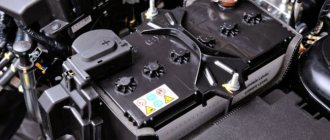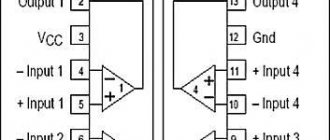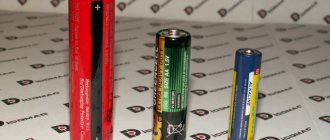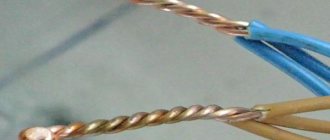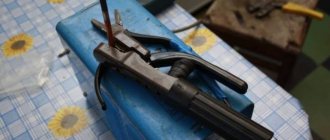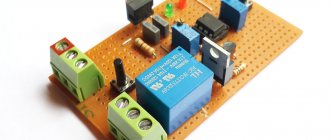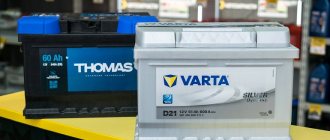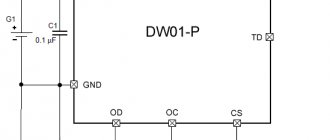Home / Devices
Back
Reading time: 3 min
0
1247
Equipment for welding work of inverter or transformer type is necessarily present among the home equipment of specialists in this profile. Welding units have long been no longer an attribute of the pros.
Anyone interested can purchase it and do small home welding tasks. Welding equipment is easy to use.
There is no need to study welding for a long time in order to weld what is required at home. Turning on the welding machine is generally easier than ever. Find a suitable electrical outlet. Turn on the welding cord.
- Introductory information
- Is it possible to cook using a car battery?
- Own experience of cooking from a car battery
- Is it worth welding from a machine battery?
- Safety regulations
- Summary
Introductory information
In theory, everything seems much simpler. But in application, certain conditions must be met. The current in the electrical network must remain uninterrupted and not fall below 180 Volts.
Or your welding unit must cope with low voltage work. Such equipment is not cheap.
It is not even discussed that you must have access to electricity. But some country houses and dachas, garages located far from the urban area are not connected to electricity.
What to do in this case. Our opinion comes down to buying a fuel generator for welding. But not everyone wants to spend extra money, especially if you rarely use welding.
The correct option under such circumstances is to use a 12-volt car battery. Some specialists manage to connect the battery to a welding inverter.
Even to carry out non-long-term welding. In our review we will write whether it is possible to carry out welding tasks using a 12 Volt battery. Is it really necessary to take such risks?
Cordless welding machine LK-power ARC-140i (ASA HW-604)
You thought it wasn’t real, but it exists - a cordless welding machine (autonomous welding machine) LK-power ARC-140i (ASA HW-604) . A battery-powered welding machine or you can call it a battery-powered welding machine. You can already buy it and perform welding work regardless of the availability of electricity.
Welding work in any conditions: at altitude, in the field, in the forest, in the mountains. Where there is no electricity at all or its power is not enough to carry out welding work, the ASA cordless welding machine will help you. Lightweight and compact, manufactured using the most modern technologies.
An autonomous welding machine on one charge under normal operating conditions will allow you to use from 16 to 20 3 mm electrodes. Automatic adjustment of arc power, multi-level protection of the built-in battery, moisture and dust protection. You will not find analogues of this device in Russia, and foreign devices will lose to it in cost.
Test the device in continuous welding mode, electrode diameter 3.2 mm.
Carry out welding work in places where you will not have competitors. With the ASA welding machine, there is no need to carry around a gasoline generator of decent power, refuel and maintain it. Even if long-term welding work is required, “ASA” will cope with it perfectly using a low-power 2 kW generator or a regular residential consumer network of 220 volts. The built-in battery will automatically add the necessary power to the output of the welding machine, and during breaks it will be quickly recharged from the mains.
In autonomous mode, the lithium battery ensures complete independence from the current source. It is portable and has a stable power output, ideal for working in mountainous areas, high-altitude work, during crisis situations and other cases where it is impossible to provide welding work with an alternating voltage source or it is labor-intensive.
We have a patented welding power enhancement technology. In addition to the stand-alone mode, welding can operate in a hybrid mode when the AC source is unstable or the work comes from a low-power generator. The welding machine has the function of amplifying the power of the external supply current to increase the welding current and the quality of work.
You can operate the device even when it is connected to the network. The device always runs on battery power - both when charging and when welding; The welding current comes from the battery. Because of this, the power consumption of the device is always the same - 1 kW.
Peculiarities
- The autonomous welding machine is designed to work in places where there is no access to a 220 volt power supply;
- “Quick start” function;
- Ergonomic welding machine control unit;
- Intuitive interface, ergonomic dimensions, easy to transport and operate;
- Soft start, automatic arc power adjustment, non-stick function;
- High precision welding current display;
- The battery pack is housed in a durable case, is moisture- and dust-proof, and can withstand falls;
- Efficient duty cycle, smooth and stable welding performance;
- LED indicator of battery charge and discharge;
- Lightweight metal body, front and back panels made of high-tech plastic;
- The high-tech charging unit ensures long battery life, fast charging mode, and protection against overcharge and overdischarge.
Contents of delivery
- Welding machine control unit;
- Emergency battery shutdown unit;
- Charge and discharge balancing board;
- Lithium battery pack protection board;
- Lithium battery pack;
- Charge connector.
Is it possible to cook using a car battery?
Is it possible to carry out welding work using a 12 Volt battery? All owners of remote country houses and garages where there is no electricity are thinking about this. The mains current simply may not be enough to operate the inverter equipment.
This point is the subject of controversy. Of course, you can take the battery from your car, charge the welder, then return it to its place.
But additional questions arise. How good and strong the weld will be. Will the weld burn out? Will the battery itself deteriorate?
Based on our own experience, we declare that it is possible to cook using a 12-volt car battery. We will not say that machine batteries are suitable for powering a welding unit.
But they will be good additional insurance for these purposes. Car batteries have a large power reserve. Theoretically, they can charge a low-power welding inverter.
Is it possible to weld using a battery?
Where might battery-powered welding be needed? The first thing that comes to mind is a dacha or a country plot. Many dachas are still not electrified, and sometimes there is electricity, but its voltage is not enough to power even a budget inverter. In this case, you can try to power the device using a battery. But at this stage many people have difficulties.
Cordless home welding... Is it possible? Will the device burn out? How good will the seam be? Masters usually have a lot of questions about this. And this is no coincidence. Many people have heard about the possibility of welding from a battery, but they do not dare to repeat it because they are worried about the device.
We hasten to reassure you: welding from a battery is possible if you use it wisely. The batteries have a good power reserve; in theory, one battery can power the device up to 600 Amps. But to obtain a more or less high-quality seam, you need to take into account a number of features.
Own experience of cooking from a car battery
We will look at our own experience of using a car battery to power an inverter unit. You can test it yourself and duplicate our work to verify what you have received.
It should be noted that one regular car battery will not be enough. Know this is a fact. At first we wanted to power the inverter from one car battery.
Welding was carried out at low current, using electrical connections 2 mm thick. The arc hardly ignited. The seam went with considerable effort. Then they took out two car batteries and connected them one by one.
Personal experience of welding from a battery
We will talk about our experience in using batteries as an inverter power source. You can conduct the test yourself and repeat our steps to verify the result.
Let’s say right away that one standard 90Ah battery will not be enough. Just take it for granted. At first we tried to power the inverter from one battery. We cooked at a low current using electrodes with a diameter of 2 mm. The arc was practically not ignited, the seams were made with great difficulty. Then we took two batteries and connected them in series.
The work went a little easier, but the result was still far from ideal. The seams were made a little easier, but the arc still “walked”, burned unstably, sometimes even went out, and the whole ignition process had to be repeated again. The end result was very defective seams with lack of penetration. In this case, the electrodes strongly stuck to the metal, and their consumption increased significantly. In short, the welding was unsuccessful.
We could have given up on this idea, but there was another battery lying at the dacha and we decided to connect it to two other batteries. And this option turned out to be the most viable. When using three batteries, the power reserve is so large that, in principle, it is possible to achieve more or less stable operation of the welding machine.
We experimented with different settings, increasing and decreasing the current, and using electrodes up to 4 mm. And overall everything went well. Of course, welding from batteries is not as comfortable and simple as from a regular outlet. But if you watch the arc carefully, you can understand its behavior and adjust. Moreover, when powered by 3 batteries, the arc behaves much more stable and is easier to ignite.
During our experiment, we found out that three batteries can be used not only for welding, but also for cutting metal parts of small thickness. But the cut is not very beautiful.
By the way, do not forget to monitor the current strength. Do not set the values too high, as batteries tend to increase the final current to too high values, and you may simply burn through the metal. And in general, carefully monitor the progress of work. Because welding from a battery requires care and skill. This is the only way to make a more or less normal seam.
Is it worth welding from a machine battery?
The welding process from a 12 volt car battery is real. We advise using this method only in exceptional cases. The only advantage of this method is welding outside the home. And there are many more disadvantages.
The biggest problem is the almost uncontrollable voltage when welding from a car battery. Batteries may increase the initial voltage reading, so you will not be able to calculate the actual voltage numbers.
It's uncomfortable. Such differences contribute to defects in products that you cannot influence.
Also, due to uncontrolled voltage, the welding unit will burn out very easily. Our inverter equipment remains intact.
But if you use it awkwardly, you will be left without three batteries and a welding unit. In this case, be prepared for excessive consumption of electrical conductors.
In addition, when using the auto battery to fuel welding work, it is no longer worth putting it back in the car. Better to play it safe.
The eternal question is whether it's worth it. Only if you urgently need to work with welding equipment, but there is not the slightest chance of getting power from a regular outlet.
If you have extra money, it is better to buy a fuel generator. You will be able to organize the process not only with a welding unit, but also successfully connect other electrical tools. This is the best best way out of the situation.
So don't stress and buy a fuel generator. You can choose a small-sized and low-power option. It will easily fit in the trunk of your car.
You will transport it without much effort. They are very economical in fuel consumption and can operate for a long time. The generator can cope with ensuring the operation of the entire arsenal of your power tools.
Battery powered spot welding device
Creating power supplies for various devices using compact and capacious lithium batteries or repairing and replacing a failed element requires a special approach. The fact is that lithium sources cannot be overheated, otherwise they will fail. There is a serial connection, which allows you to increase the total voltage at the outputs of the unit, or a parallel connection, which increases the capacity of the power source. Each element is connected by spot welding using nickel-coated steel tape, which is commercially available in the form of coils.
For such a one-time task, you should not buy professional and expensive equipment. It is easier to create a simple spot welding machine using a used car battery.
You can get by with a minimal set of tools and components that can be found in the house or on sale, for example:
- battery with a capacity of 55 a/h or more and a voltage of 12 V, in a charged state;
- power wire with a cross-section of more than 6 mm2 for connecting the battery terminals with homemade electrode holders;
- two probes adapted for fastening copper replaceable electrodes, the diameter of which must be at least 3 mm;
- a cassette for fixing each battery during assembly into a block;
- nickel tape measuring 0.12 X 7 mm of the required length;
- scissors and degreasing solvent;
- protective insulating rings to prevent leaks.
It is very important before assembling the power supply to check each lithium-ion source for functionality and charge them to the same level.
Wires are attached to the electrode holders, which are subsequently securely fixed to the battery terminals, and the contacts of the lithium cells are cleaned of the oxide layer. Lithium ion batteries are fixed in cassettes to maintain immobility and alignment during the welding process.
The nickel-plated tape is cut to size and leveled, then it and the batteries are degreased. The tape is applied to the pole contacts and welded crosswise to the batteries with electrodes. During a point discharge, it is necessary to ensure that the electrodes are pressed against the surface of the parts, and the pulse should last no more than 1-1.5 seconds.
Safety regulations
In appearance, the car battery is absolutely safe. All its parts are inside a strong case. This impression is deceptive.
You should not be negligent about the safety rules when using car batteries. Moreover, when ensuring the operation of the welding inverter.
If you want to remove the battery from the car, move it or perform any actions, use special gloves. The most correct and safe option is also special clothing for these purposes.
But if this is an unplanned event, you are unlikely to follow her. Therefore, we will limit ourselves to thick gloves.
If electrolyte has dripped onto an open area of your body, you should immediately rinse the area. This area can be treated with a solution of soda or ammonia diluted with water.
Remove gloves and wash your hands well with soap. Don't eat near batteries, don't smoke, and generally be careful. If you are tired and need to take a break, place the car batteries in an isolated room and you should go out.
If your car batteries become dusty, they need to be cleaned. This is done using ammonia diluted with water. Use a clean, dry cloth.
If you have removed the batteries from your car, clean the plugs to ensure there is no dirt left behind. To prevent the formation of excessive gas pressure.
Remember that car batteries can become a threat to your health. When working with your car's battery, take good care of your body and mucous membranes from damage by acid.
You may get a serious burn. You should definitely have a fire extinguisher in your garage. If handled incorrectly, problems can also occur with welding equipment.
These are absolutely simple safety rules. But not all masters remember this when they start working with devices. Remember that it is better to prevent problems from arising than to eliminate the consequences later.
Choosing a machine for spot welding batteries from AliExpress
Recently, spot welding machines have become quite affordable. And many DIYers and others buy them for welding batteries. (although to be precise, many DIYers make these devices themselves from transformers and controllers) I personally also did not ignore this topic, and bought myself a spot welding machine. Small, not very powerful, with a built-in battery. It’s enough for me for infrequent and small-scale work (I sometimes cook lithium into assemblies).
Below I will give several interesting models of welding machines, sorted by price/quality/popularity, which in my opinion are interesting to buy. But naturally, this selection of articles is more of an advisory nature, and is needed primarily for selecting suitable devices according to the criteria. I'm not saying that you need to buy this or that welder, I'm just showing what options exist to make it easier for you to choose the right one for you.
Mini Spot Welder
Mini Spot Welder
This is a small compact welding machine that can be powered from 9-12V. It is suitable for welding small assemblies using thin nickel strip. It is more than suitable for one-time work, or for urgent work in the field, far from an outlet. Of course, it doesn’t have enough power for serious work. By the way, his price is very reasonable.
BIFRC welding machine
BIFRC welding machine
Another option for a welding machine without connection to an outlet. This is also a low-power device, but it is enough for small jobs. The advantage is that this is a ready-to-use device. It has a built-in 5500mAh battery that can be charged via the Type-C port from any USB source. The declared power is 4.2 V Max 650A, which is enough to weld a tape of about 0.1-0.15mm.
Capacitor welding machine
Capacitor welding machine
This device is interesting, of course, because it runs on batteries and not on capacitors. This solution has its obvious advantages: fast charging, no battery degradation, good power. But the downside will be the price, since good capacitors are expensive. The lot has very good reviews. Judging by the characteristics and reviews, this welding machine easily welds nickel strip up to 0.15mm thick
Spot Welding Control Board
Spot Welding Control Board
This is an option for do-it-yourselfers. Here you need to add a power source and transformer. But on the basis of such a control board, you can assemble a powerful welding machine capable of welding strips with a thickness of more than 0.2 mm. This lot has a large number of orders and a lot of reviews, from which you can glean a lot of useful information about what kind of assemblies different people make.
Welding machine in the form of a handle
Welding machine in the form of a handle
Quite an interesting and convenient solution. Welding machine in the form of a handle. Fits in your hand, does not take up much space, compact. It is stated that this welding pen has a built-in battery with a capacity of 7000 mAh. It can be charged via the Type-C port from any USB source. The specifications indicate that the maximum thickness of the welding tape is up to 0.2mm
Welding machine Sunko 737B
Sunko 737B
This welder is already closer to industrial options. Suitable for battery welding with tape up to 0.2mm and supports high load and large work volume. Such welding machines are suitable for those who do a lot of welding and assemble batteries, although in terms of price segment and power, this is still an entry-level budget model.
Welding machine SUNKKO 737G
SUNKKO 737G
Another option for a more professional welding machine. It differs from the previous version in a higher price, but there are already two options for placing electrodes. In addition, this device can weld tape up to 0.35mm, which makes it more suitable for those jobs that require large assemblies on thick nickel tape for high currents.
Welding machine SUNKKO 737DH
SUNKKO 737DH
This spot welder supports strip welding up to 0.35mm, and has a power up to 1200A. It is suitable for professionals, but at the same time has a relatively low cost. There are also a large number of power and pulse duration settings. And the welding process is controlled by pressing the foot pedal. In general, this is currently one of the best options for home and other craftsmen.
I selected welding machines according to the principle from cheaper simple ones to more expensive and powerful ones. In general, they all differ in power and the ability to weld nickel strips of different thicknesses for different tasks. But all the proposed options have many orders and good reviews. Read, compare, I think the selection will be useful for those who are currently choosing a machine for spot welding 18650 batteries, etc.
How to weld using a battery
- January 15
- 21 ratings
Many people, working in a garage or in a country house, were faced with the need to connect parts by welding, without having a welding machine. In some situations, battery-powered welding is possible. It is not always acceptable, as it has a number of limitations. However, the undeniable advantage of such work is the simplicity and accessibility of welding.
The device of an inverter welding machine.
Welding from a battery can also be carried out using inverter machines that are connected to the battery. Some car owners specifically purchase batteries for welding work. At the same time, spot welding performed using a battery is much more durable than soldering. How to carry out welding work from a car battery, what parts and materials are needed for this, will be discussed below.
Brief description of welding methods
Classification of types of welding.
People who weld quite often regularly face the problem of voltage drops in networks under high welding loads, which occurs both when using old welding transformers and new inverter machines. Often, when connecting welding devices, the voltage drops by at least 30 Volts. Such a drop is serious and may affect the operation of household appliances.
Therefore, before starting welding work, according to the legislation of the Russian Federation, it is necessary to warn all neighbors who are powered from the same line. This creates a lot of inconvenience, and neighbors may refuse to carry out such work. The way out of this situation is battery welding.
When and where it first appeared is unknown, but the first documented (filmed) process was in the 60s of the last century.
The authors are Soviet polar explorers who traveled to the site in cars.
The physics of this process is no different from conventional welding. Just like ordinary welding, welding from a battery occurs when an electric arc is formed. In this case, a permanent welding connection also occurs at the molecular level - the heated metal begins to melt, forming a seam.
Assembly diagram of a welding machine for soft welding.
At the moment, such welding can be performed in three ways (conditional division):
- Spot welding using bare contact wires. Requires a minimum of preparation, materials, and labor costs. It happens very quickly, the connection is much weaker than a conventional weld. During such welding, copper wires will protrude as electrodes.
- Connecting multiple batteries to a battery pack. This will allow welding work to be carried out using carbon electrodes of small diameter (up to 3 mm). In this case, the diameter of the electrode depends on the maximum current supplied by the battery.
- Connecting several batteries into a battery and connecting an inverter welding machine to it. In this situation, welding work is carried out as standard, only the power source changes.
The choice of welding method depends on the materials of the parts being welded. Thus, the connection of non-ferrous and alloyed metals must be performed by spot welding (point 1) or carbon electrodes (point 2).
Ferrous metal connections are made only with welding inverters (point 3). Inverters can also weld non-ferrous metals, but since the welding process using inverters is not new, there will not be a detailed description here. The only thing worth noting is the need to connect 3-4 batteries of the same capacity and the same output current into one battery. It is worth noting that the inverter quickly drains the battery from which it is powered. Therefore, it is necessary to constantly monitor the charge level by connecting a measuring device to the battery.
Return to contents
Gas shielded welding diagram.
All these processes have their advantages and disadvantages, so the practical use of batteries for welding depends on specific conditions, financial capabilities and the availability of necessary materials. The positive points include the following:
- Ability to carry out welding work in extreme conditions. For example, on the road, in the field, etc.
- Possibility of welding in the absence of specialized equipment. However, in the absence of an inverter, only non-ferrous metals can be welded.
- No voltage drops in networks. Since the process is carried out using an autonomous energy source, it does not harm the operation of the network.
- Ability to work under almost any external conditions. If the equipment is properly connected, welding can occur in hot or cold (temporary), during precipitation, etc. To do this, it is necessary to strictly follow certain rules for performing such work.
- Dead batteries can be reused after recharging.
However, this process has a number of disadvantages:
- The main disadvantage is the rapid discharge of the battery. Therefore, it is very important to monitor its capacity. To do this, a measuring device is installed in the circuit.
- Intensive discharge of batteries significantly reduces their service life. Therefore, it is necessary to constantly monitor the battery’s ability to hold a charge and replace batteries that do not hold a charge.
- Financial expenses. If only one car battery is needed for spot welding, then for welding with carbon electrodes or to connect an inverter, a minimum of three batteries are required, which are connected in series.
- Many people, when using batteries for welding, often neglect safety rules. However, despite the apparent simplicity of such work, it is possible to receive various injuries when performing it.
Return to contents
Spot welding diagram.
Spot welding using a battery is considered the most primitive. To complete this you will need one battery, wires, and a pair of terminal blocks. But let's take a closer look
Before performing welding work (this applies not only to spot welding), it is necessary to follow some safety rules. The first is eye protection. Naturally, in field conditions a person will not have a welding shield (mask), just as most car enthusiasts do not have one in garages. However, sunglasses can provide minimal protection during short-term work. The next important point is the insulation of the wires. It must be intact and not collapse. Since such welding work requires a current of at least 150 amperes, it is necessary to protect yourself from electric shock. Lastly, as when performing any complex work, attentiveness and accuracy are required.
To assemble a spot welding device, it is necessary to connect insulated wires with a cross-section of at least 5 mm to the battery terminals (the choice of cross-section depends on the battery current), the correct selection of the wire cross-section is monitored during operation - the wires should not get hot. The wire leads should be connected to a terminal block (Soviet BZN will do) with a rated current of about 200-250 amperes. Next, wires are connected to the terminals, which will serve as electrodes. They must be rigid, their cross-section must coincide with the cross-section of the output wires, and they must be insulated. Next, their terminals are placed at a distance of up to 3 mm from each other (however, they should not be in contact) and the wires are fixed in this position with improvised materials (household feed-through terminals are well suited for fixing). The ends of the wires are stripped of insulation, and the device is ready for use.
To weld 2 parts, they should be connected to each other, and the cleaned wires of the device should be attached to the connection point on one side. Important: for welding, only the ends (section) of the wires are applied, and it is necessary to ensure an even cross-section of each wire (for this, the i.x is equalized with a needle file).
Return to contents
To perform such welding, it is necessary to connect 3 or more car batteries into a battery. Connections are made with large cross-section wires. Wires with powerful crocodiles at the end are connected to the battery terminals. Crocodiles act as clamps. One clamps the electrode, the other clamps the working part.
The further process is carried out similarly to conventional welding. It is important not to use thick electrodes (maximum cross-section - 3 mm). You should be careful when working, since crocodiles have a large uninsulated surface area.
expertsvarki.ru
